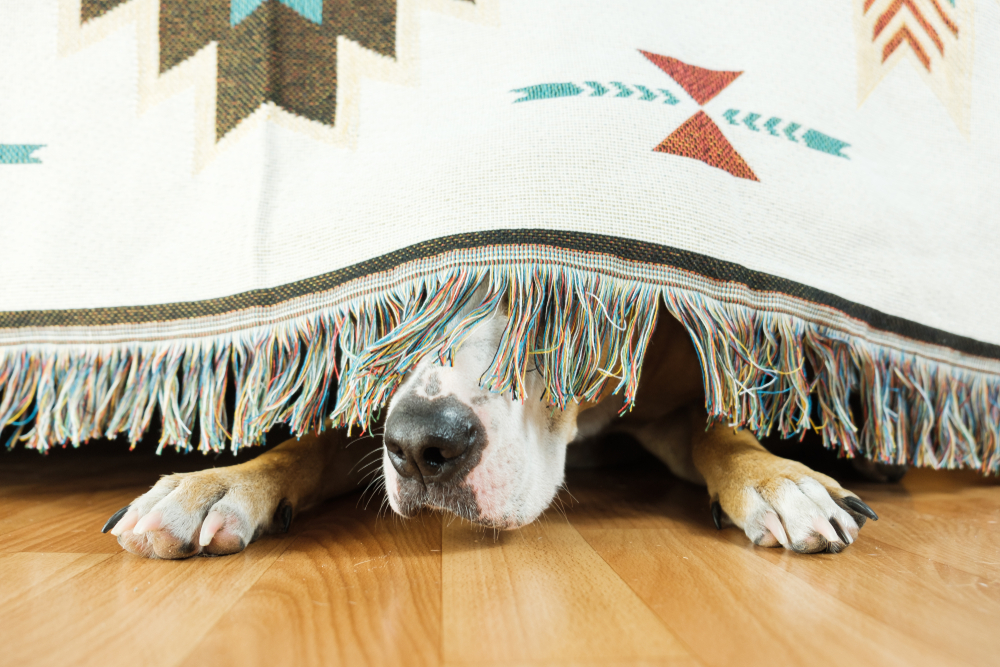
[ad_1]

My golden retriever Angus can feel a thunderstorm coming when it’s still hundreds of miles away. He starts panting, shaking and walking from room to room, trying to find a safe place to hide. And he’s not alone. Dogs are more sensitive to loud sounds compared to humans, and they may also be more aware of changes in air pressure that occur when a storm is coming. According to experts, dogs are instinctual, so while they might not realize why they’re scared, they can sense a threat is close by.
But it’s not just storms that make our pets nervous. Going to the veterinarian, riding in a car and meeting strangers can all have the same impact, depending on the animal. So how do you know whether your pet is anxious, and what should you do about it?
Read More: Why Some Dogs Fear Fireworks and What To Do
Kristi Flynn, an assistant professor in the College of Veterinary Medicine at the University of Minnesota, says that several signs can point to pet anxiety. “While dogs and cats can’t verbalize that they are anxious, we can tell through their body language and in some cases, vocalization,” says Flynn.
Signs Your Pet is Anxious
Noting these more subtle signs of anxiety and taking measures to make them more comfortable may help calm your pooch down, says Flynn. Here are some signs to look for:
-
Panting without being hot
-
Yawning without being tired
-
No appetite
-
Holding ears back
-
Showing the whites of their eyes (This is called whale eye.)
-
Lifting up their front paw
-
Leaning away from you
-
Furrowing their brow
If anxiety isn’t addressed in dogs, it can progress into more serious signs of anxiety like:
-
Urinating or defecating
-
Damaging doorways
-
Barking or howling
-
Snapping or biting
According to Flynn, cats aren’t as obvious in how they show anxiety compared to dogs. But there are a few signs to look for. “Note dilated pupils or if they are seeking seclusion or attention more than usual. Sometimes cats resort to over-grooming or inappropriate elimination as a result of a stress-inducing trigger,” she says.
What to do if Your Pet is Anxious
It really comes down to avoiding the situations that make your pet feel anxious. In some cases, this isn’t possible. I can’t stop thunderstorms from terrorizing Angus, but I can take steps to make the situation less anxiety-inducing.
Dog trainer Michelle Lehr says you should make sure your dog feels like they have a safe place to go that limits disruptive noise and chaos. Talk to your veterinarian about medications as well as alternative treatments like CBD, acupuncture and even pet massage.
Additionally, says Lehr, a physically active dog tends to be less anxious. They need “plenty of exercise and playtime; this is very beneficial for physical and mental health,” she says.
Some research has also shown that “desensitization or counter-condition training” through a dog trainer can help pets work through their anxiety. A 2019 study published in the journal Animals looked at whether desensitization training could reduce fears around veterinarian visits. The technique involves exposing pets to lower levels of a stimulus that they would normally find scary in an effort to reduce a pet’s anxious response.
According to the study, “owners reported an observable improvement in their dog’s fear levels across the training sessions, and general fear scores lowered during the second examination for trained dogs.”
Read More: Dogs May Be Smelling Our Stress
In the end, some pets are just more anxious than others, just like some humans are more anxious than others. But you can take steps to make their environment more calming and less chaotic. Provide your pup with a safe place they can go to escape with their favorite toys and treats, a comfy bed and, of course, lots of cuddles.
[ad_2]